^zhurnaly 0.9908

Howdy, pilgrim! No ads — you're in volume 0.9908 of the ^zhurnal (that's Russian for "journal") — see ZhurnalyWiki for a Wiki edition of individual items; see Zhurnal and Zhurnaly for quick clues as to what this is all about; see Random for a random page. Briefly, this is the diary of ^z = Mark Zimmermann ... previous volume = 0.9907 ... complete list at bottom of page ... send comments & suggestions to "z (at) his (dot) com" ... click on a title link to go to that item in the ZhurnalyWiki where you can edit or comment on it ...
RSS
~49.5 miles @ ~14 min/mi
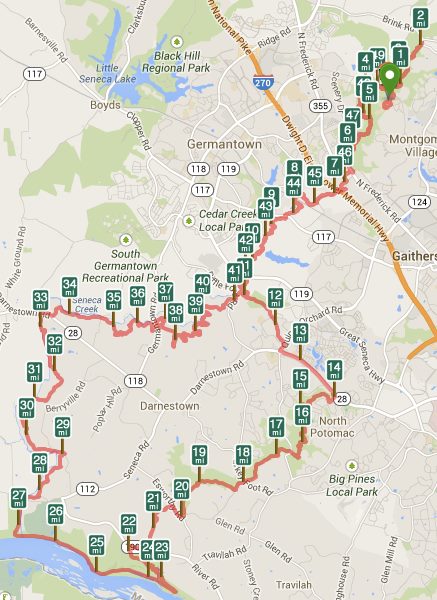 | The MCRRC Stone Mill 50 miler turns out extraordinarily, uneventfully well this year, after a DNF in 2012 and a fun-but-rough off-course detour in 2013. The weather is great, the volunteers are helpful, the route is lovely, and there's wonderful conversation and fellowship among the ultrarunner participants all day long. Official results put me across the line in 181st place (of 252 listed finishers) with a time of 11:40, and 140th of 179 males. The Garmin GPS measures 47.8 miles with 3800 feet elevation gain; Runkeeper on the iPhone more generously estimates 49.6 miles and 5000 feet climb. |
| This great photo of ^z at mile ~6 is by Dan Reichmann (click for high-res version). My son Merle captioned it, "My dad, giving that ridiculously photogenic runner meme guy a run for his money." | 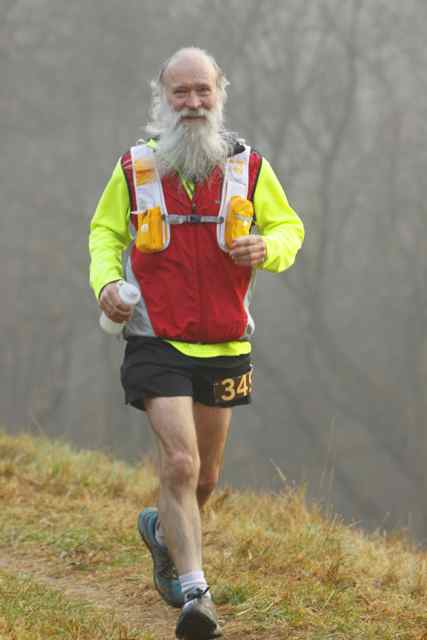 |
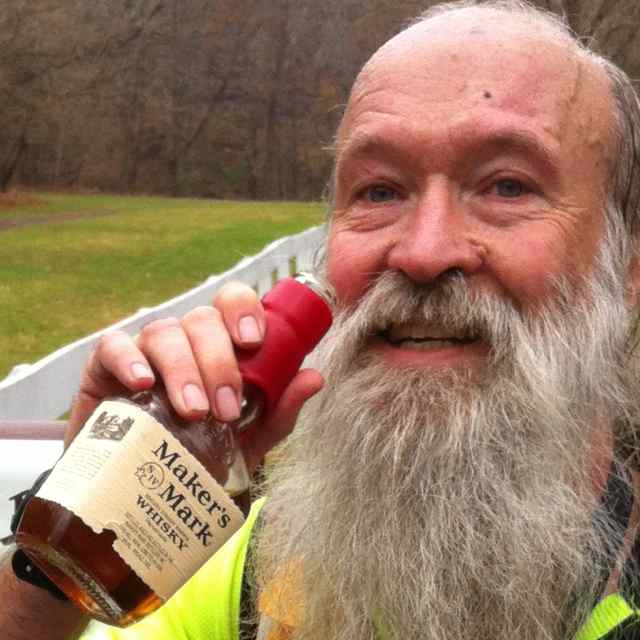 | At the mile ~23 aid station, just before runners leave Muddy Branch Trail and join the C&O Canal towpath, Quatro Hubbard supplements the usual fluids with a special high-octane recovery drink. |
| Cheerful friends Stephanie Fonda and D. Marshall Porterfield lead me most of the way today. This photo of them is by Tom Foreman. | 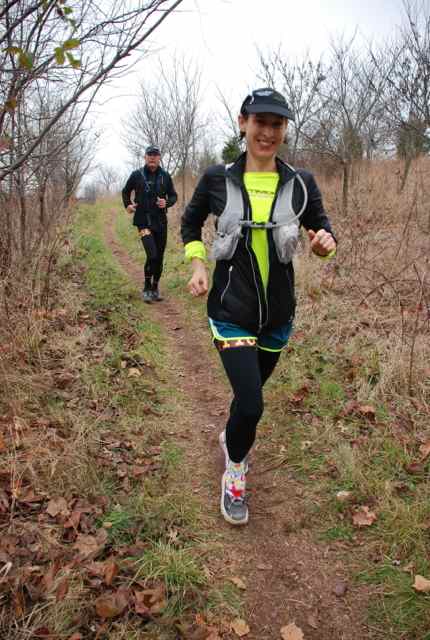 |
| About 5 miles after not sampling Quatro's kind offer of whiskey, I'm descending a steep hill just ahead of my ultra-mentor Professor Paul Ammann (cf. Injury Avoidance, UltraMan, etc.) I'm chattering away, slip on wet leaves, and suddenly find myself in Mother Earth's cold embrace. "That was a full-body fall!" Paul helpfully observes, as I clamber to my feet, fortunately undamaged. A few hours earlier in the race, as the morning fog lifts, a haiku springs forth:
Stone Mill mile 19
Naked tree beside the trail
Bejeweled in dewdrops Many miles later, in the deepening twilight:
Stone Mill mile 40
The sun sets, the moon rises,
And the trail goes on Finally, with a minute of poetic license on the total time so the syllable count scans:
Stone Mill finish line:
Time 11:41
And only one fall! The photo is by Paul Encarnación (click for high-res version). | 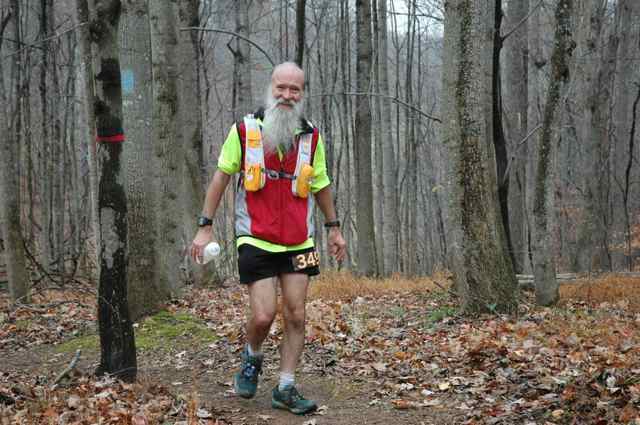 |
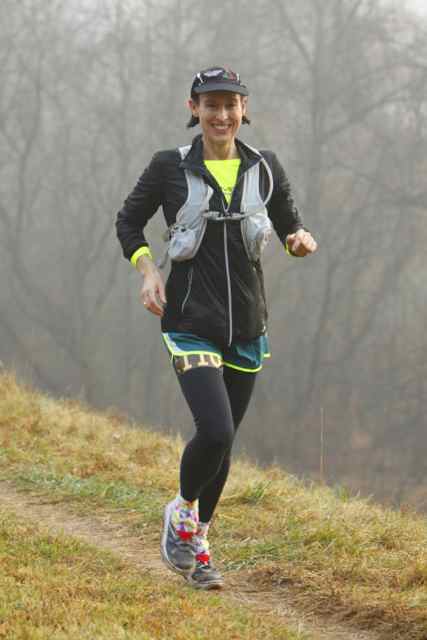 | Comrade Stephanie Fonda is caught in a happy morning moment by photographer Dan Reichmann (click for high-res version) near mile 6. |
| On Tschiffley Mill Rd, near mile 28, I make new friends: Janet Choi (aka "Tape Girl", as per her knee and calf bindings), KC Guevara, and Toni Aurilio. They're flying along so cheerfully that I can't resist pausing to take pictures. KC and Toni finish a few minutes in front of me; Janet is not far behind. | 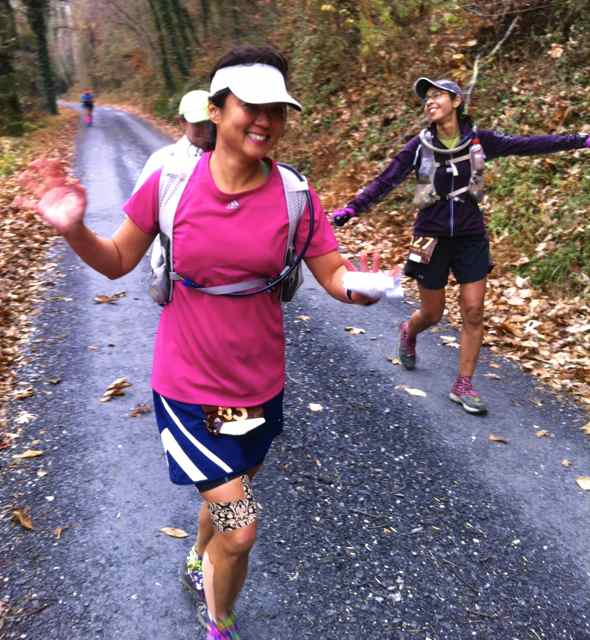 |
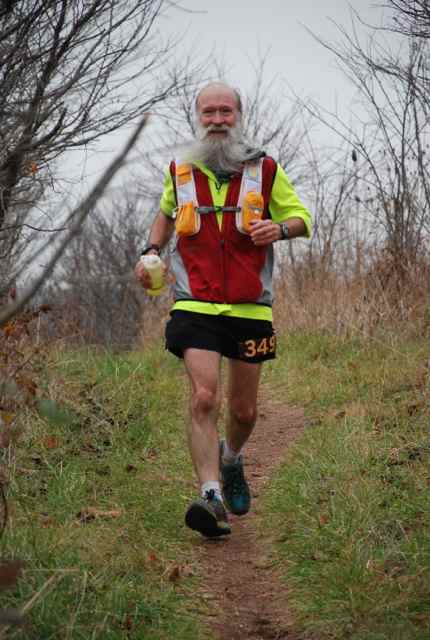 | Today I'm testing out a new minimalistic vest, the Nathan HPL model #028. It has a pouch on the back which holds an extra water bottle, and ample zipper pockets for candy, gels, Succeed! electrolyte capsules, and cellphone with supplementary battery pack. The photo of me is by Tom Foreman (click for high-res version). |
| I cross the finish line a few seconds behind Stephanie and Marshall. Kind friend Barry Smith comes in a bit later. It's a long, great day! | 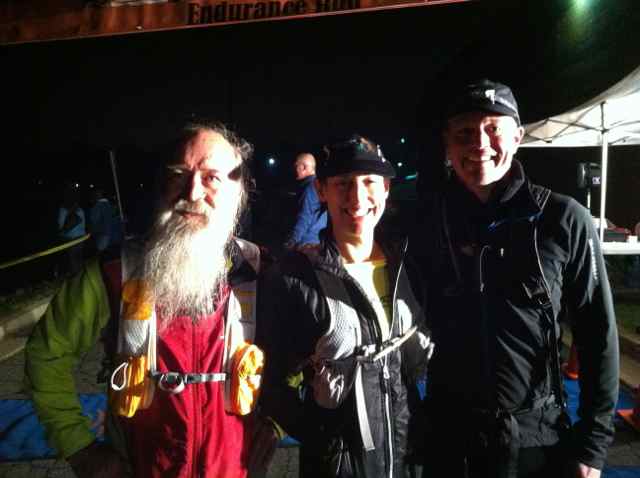 |
- Sunday, December 08, 2013 at 18:48:09 (EST)
My office-mate reported yesterday that she did not do well in computer language class:
(ok, maybe it's an oldie, but it was new to me!)
- Friday, December 06, 2013 at 04:04:30 (EST)
A pre-literary-award-party speech by novelist Jeffrey Eugenides appeared in the New Yorker online a year ago. It's titled "Posthumous" and advises young writers to be true to themselves and to work as though they're already dead, "... as if the usual constraints—of fashion, commerce, self-censorship, public and, perhaps especially, intellectual opinion—did not operate..." (as Eugenides quotes Christopher Hitchens).
Early in his talk Eugenides offers a brilliant prose-poem explanation of why to start writing:
... it wasn't out of a wish to be published, or to be successful, or even to win a lovely award like the one you're receiving tonight. It was in response to the wondrousness and humiliation of being alive. Remember? You were fifteen and standing beside a river in wintertime. Ice floes drifted slowly downstream. Your nose was running. Your wool hat smelled like a wet dog. Your dog, panting by your side, smelled like your hat. It was hard to distinguish. As you stood there, watching the river, an imperative communicated itself to you. You were being told to pay attention. You, the designated witness, special little teen-age omniscient you, wearing tennis shoes out in the snow, against your mother's orders. Just then the sun came out from behind the clouds, revealing that every twig on every tree was encased in ice. The entire world a crystal chandelier that might shatter if you made a sound, so you didn't. Even your dog knew to keep quiet. And the beauty of the world at that moment, the majestic advance of ice in the river, so like the progress of the thoughts inside your head, overwhelmed you, filling you with one desire and one desire only, which was to go home immediately and write about it. ...
Key to it all, the central imperative: "You were being told to pay attention."
(cf. NotEasy (2001-03-31), TheClassicist (2004-09-09), DangerousLiterature (2006-03-03), This Is Water (2009-05-21), Coming Back to Your Breath (2011-09-25), Bringing Back a Wandering Attention (2013-02-13), Being Still (2013-05-20), ...)
- Thursday, December 05, 2013 at 04:44:12 (EST)
Based on a true story: the dashboard clock on your car only shows hours and minutes (not seconds). You know the clock is only accurate to plus or minus a few minutes; likewise, your digital watch is set to within a few minutes of true time. Assume the car's clock and your watch are independent, equally likely to have any error within that range, but both running at the same rate so the difference between them is a constant.
At a random time you observe the car clock and your watch. At the moment that you do the comparison, you see that they display the same time in hours and minutes (HH:MM displays are equal; seconds are not shown).
Question: after that single observation, what is the likely difference in seconds between the clock and the watch?
This actually happened to my son Robin and me a few months ago, and it provoked a fascinating debate between us (and within myself). Clearly the time difference in seconds — call it Δ ("delta") — could be any value between plus or minus a hair under 60 seconds for two clocks that have the same HH:MM values at a given instant. How likely are the clocks to differ by less than a second? By 29-30 seconds? By 59-60 seconds? By an arbitrary number of seconds? Remember, you can't see the seconds on the car clock display, only the hours and minutes, and before making the comparison you only knew that both timepieces were in error by arbitrary independent amounts within a few minutes of the true time.
One of us argued that, after seeing matching HH:MM displays, the clock and the watch are equally likely to have any offset within the allowed range: -60 < Δ < 60 seconds. That's all that a single observation can tell you, logically. The other of us felt strongly that the odds favor a smaller Δ, since for example if the difference between the unseen HH:MM:SS displays is 59 seconds then only one observation in 60 will show matching HH:MM values and 59/60ths of the time the clock and the watch won't agree. Contrariwise, if the unseen difference between clock and watch is only 1 second, then 59 times out of 60 they will match. This position suggests that the probability P of any value of Δ between 0 and 60 should be peaked at Δ = 0 and decrease linearly to vanish (P = 0) when Δ = 60 seconds.
And even more amusingly: every twelve hours over the following two days my belief flipped back and forth between the two positions! The arguments on each side seem plausible.
So what do you think? To be continued ...
- Wednesday, December 04, 2013 at 04:38:37 (EST)
A fascinating plaque, spotted recently in a high school music room:
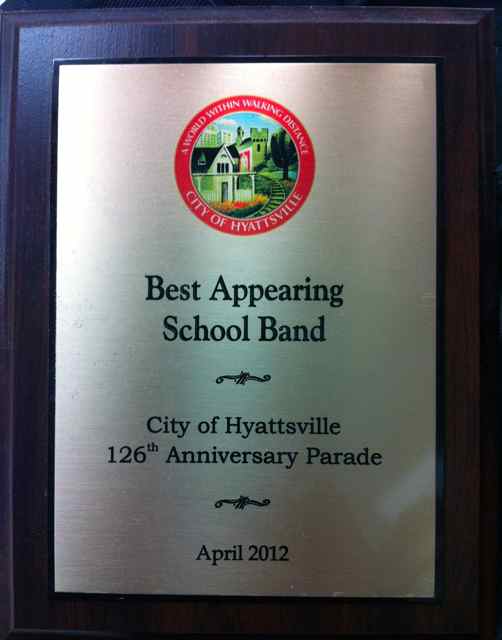
No doubt the award is meant to applaud sharp costumes — but the word "appearing" suggests pretense rather than reality, as opposed to Sallust's description of Cato, "He preferred to be good rather than seem so."
Or maybe they were just the best band that appeared in the parade that day?
- Tuesday, December 03, 2013 at 04:26:28 (EST)
Truths? Debatable. David Wong's crude essay "6 Harsh Truths That Will Make You a Better Person" offers some rough-edged comments on how to make the best of life — a modern short-attention-span version of Arnold Bennett's 1923 How to Make the Best of Life, perhaps. Wong's manifesto, in the countdown order that he offers them:
6. The World Only Cares About What It Can Get from You (not just being a nice guy)
5. The Hippies Were Wrong (what you do matters more than what you "are")
4. What You Produce Does Not Have to Make Money, But It Does Have to Benefit People
3. You Hate Yourself Because You Don't Do Anything
2. What You Are Inside Only Matters Because of What It Makes You Do
1. Everything Inside You Will Fight Improvement
Well, maybe not "Truths". Certainly not "Six" given overlap and redundancy among the items. Definitely "Harsh" in their statement.
So upon rereading, Arnold Bennett did say it better, 90 years ago, when he observed among other suggestions:
I am far off old age, but old age is approaching daily. The terrors of old age are solitude, neglect, boredom, lack of suitable activity, utter dependence on others, and the consciousness of wasted opportunities, of having achieved less than one might have achieved. What am I doing now to destroy those terrors, or even to minimise them? Am I sufficiently providing for the final years? Am I keeping my old friendships in repair and constructing new ones? Am I, in the intervals of satisfying my greatest interest, creating minor interests which will serve me later? Am I digging my groove so deep that I shall never be able to climb out of it? Am I slacking?
Good thoughts, and not just in one's elder years ...
(cf. Optimist Creed (1999-04-16), What Is My Life? (1999-04-30), Bennett on Life (2000-03-09), Personal Energy (2000-12-08), Dear Diary (2001-03-19), Practical Productivity (2004-01-20), How to Succeed (2005-03-11), How to Win Friends and Influence People (2008-05-17), ...)
- Monday, December 02, 2013 at 04:45:46 (EST)
Statistician Jacob Cohen wrote a charming essay in 1994, "The Earth Is Round (p < .05)", about the problems with "95% confidence" testing and its misapplication. A 2011 Psychology Today blog post by Joachim Kruger, "What Cohen Meant", explains:
Jacob Cohen (1923 - 1998) was a pioneer of psychological statistics. He taught us about effect sizes, power analysis, and multivariate regression, among many other things. I have always admired his ability to combine technical rigor with good judgment. During the last decade of his life, Cohen published two particularly insightful papers in the American Psychologist. Both had to do with Null Hypothesis Significance Testing (NHST). In "Things I have learned (so far)," Cohen (1990) questioned the idea of living by p values alone and suggested the researchers avail themselves of the multiple tools they can find in the statistical box. In "The earth is round (p < .05)," Cohen (1994) outed himself as a Bayesian. He made clear what many were already dimly aware of, namely that what you want from statistical testing is the probability that an hypothesis is true given the evidence, whereas what you get from the standard tests is the probability of the evidence assuming that the (null) hypothesis is true. How to get from the latter out to the former is a matter of ongoing debate ...
Cohen's original essay is full of hilarious asides:
- "Like many men my age, I mostly grouse. My harangue today is on testing for statistical significance ..."
- "... we, as teachers, consultants, authors, and otherwise perpetrators of quantitative methods, are responsible for the ritualization of null hypothesis significance testing (NHST; I resisted the temptation to call it statistical hypothesis inference testing) to the point of meaninglessness and beyond. ..."
- "... For example, Meehl described NHST as 'a potent but sterile intellectual rake who leaves in his merry path a long train of ravished maidens but no viable scientific offspring' ..."
Jacob Cohen also offers examples of misapplied deductive reasoning, leading up to the classic:
If a person is an American then he is probably not a member of Congress (TRUE, RIGHT?)
This person is a member of Congress.
Therefore, he is probably not an American.
Cohen points out that this is formally the same as the fallacy that, if the null hypothesis is true, a given statistically "significant" result probably wouldn't occur — the root of much bad science. As Mark Reid puts it in his 2009 blog post:
| Repeat after me: "the p-value is NOT the probability the null hypothesis is true given the observed data". |
And as Reid then quotes Cohen:
What's wrong with NHST? Well, among many other things, it does not tell us what we want to know, and we so much want to know what we want to know that, out of desperation, we nevertheless believe that it does! What we want to know is "Given these data, what is the probability that H0 is true?" But as most of us know, what it tells us is "Given that H0 is true, what is the probability of these (or more extreme) data?" These are not the same ...
(cf. Medicine and Statistics (2010-11-13), Introduction to Bayesian Statistics (2010-11-20), ...)
- Sunday, December 01, 2013 at 07:22:10 (EST)
~6.3 miles @ ~9 min/mi
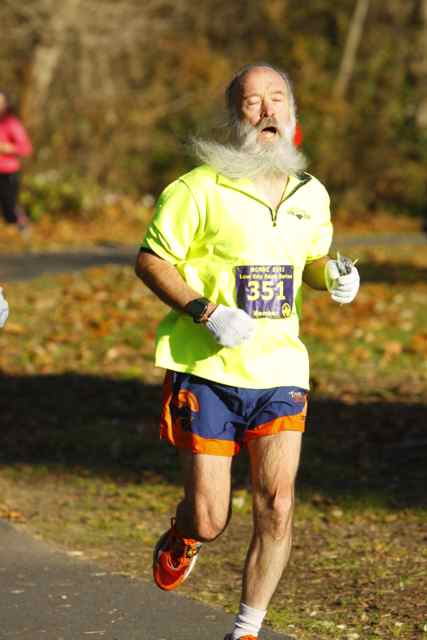 | No, it's not wise to run with eyes wide shut and mouth wide open! Image by Dan Reichmann is from the final stretch of the MCRRC "Candy Cane 5k", a fun run with good friends. Garmin GPS suggests the course was short, closer to 3.0 miles than 3.1, as does gun time of 21:50. The GPS estimates average pace of ~7.4 min/mi (with approx. splits: 7.5 + 7.5 + 7.2 min). Before the event I warm up by jogging from home; afterwards I stay to cheer runners coming in for the final 100 yards. Official results put me barely in the top 100, behind 80 men and 16 women, and 3rd of 15 among the 60-64 year old males. Runkeeper has the entire day's trekking, with pauses but no splits between the trip down to the course, the race, and the return jog. The Garmin GPS records three separate trackfiles, before and during the race and afterwards. |
- Saturday, November 30, 2013 at 16:36:23 (EST)
Richard Hamming in his 1986 talk "You and Your Research" discusses the value of regurlarly fencing off time to work on important long-term challenges:
Along those lines at some urging from John Tukey and others, I finally adopted what I called "Great Thoughts Time." When I went to lunch Friday noon, I would only discuss great thoughts after that. By great thoughts I mean ones like: "What will be the role of computers in all of AT&T?", "How will computers change science?" For example, I came up with the observation at that time that nine out of ten experiments were done in the lab and one in ten on the computer. I made a remark to the vice presidents one time, that it would be reversed, i.e. nine out of ten experiments would be done on the computer and one in ten in the lab. They knew I was a crazy mathematician and had no sense of reality. I knew they were wrong and they've been proved wrong while I have been proved right. They built laboratories when they didn't need them. I saw that computers were transforming science because I spent a lot of time asking "What will be the impact of computers on science and how can I change it?" I asked myself, "How is it going to change Bell Labs?" I remarked one time, in the same address, that more than one-half of the people at Bell Labs will be interacting closely with computing machines before I leave. Well, you all have terminals now. I thought hard about where was my field going, where were the opportunities, and what were the important things to do. Let me go there so there is a chance I can do important things.
(cf. ResearchAndLife (2000-09-07), Comments on UndividedAttention (2001-10-22), ...)
- Friday, November 29, 2013 at 04:22:43 (EST)
A list often attributed to John Cage, perhaps from artist/educator Corita Kent, occasionally credited as "Immaculate Heart College Art Department Rules":
- Find a place you trust, and then try trusting it for a while.
- General duties of a student: Pull everything out of your teacher. Pull everything out of your fellow students.
- General duties of a teacher: Pull everything out of your students.
- Consider everything an experiment.
- Be Self Disciplined. This means finding someone wise or smart and choosing to follow them. To be disciplined is to follow in a good way. To be self disciplined is to follow in a better way.
- Nothing is a mistake. There is no win and no fail. There is only make.
- The only rule is work. If you work it will lead to something. It's the people who do all of the work all of the time who eventually catch on to things. You can fool the fans, but not the players.
- Do not try to create and analyze at the same time. They're different processes.
- Be happy whenever you can manage it. Enjoy yourself. It is lighter than you think.
- We are breaking all the rules, even our own rules. And how do we do that? By leaving plenty of room for "X" quantities.
HINTS:
- Always be around.
- Come or go to everything.
- Always go to classes.
- Read anything you can get your hands on.
- Look at movies carefully, often.
- Save everything — it might come in handy later.
(cf. Riot Act (2010-07-07), Keith Johnstone's Impro (2012-11-10), ...)
- Thursday, November 28, 2013 at 12:11:54 (EST)
From Umberto Eco's 1980 novel The Name of the Rose (chapter "Seventh Day, Night"):
"... The order that our mind imagines is like a net, or like a ladder, built to attain something. But afterward you must throw the ladder away, because you discover that, even if it was useful, it was meaningless. ... The only truths that are useful are instruments to be thrown away. ..."
(cf. Go for the Moon (2013-10-26), ...)
- Wednesday, November 27, 2013 at 04:34:51 (EST)
~8.5 miles @ ~14 min/mi
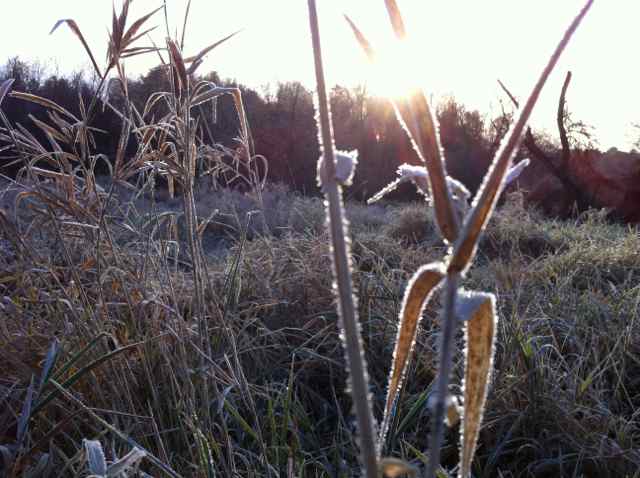 | Frost decorates the meadow as Barry Smith and I trek along Seneca Creek, previewing the first half dozen miles of next week's Stone Mill 50 miler. We ramble upstream to Brink Rd and then downstream to tag MD-355 and back. Barry spies a deer. I mishear it as "beer" and respond, "Where?? Where???" When we get back to Barry's car two hours later, we each do ~10 push-ups on the parking lot. Our hands show stigmata from the gravel surface. |
| At the scenic overlook we pause to snap photos of each other. An elderly gentleman trots past and asks if we're planning to run Stone Mill. He not, and says that he's in his 70's now and sticks to shorter distances. We salute him. Runkeeper and Garmin GPS show the route and pace details. | 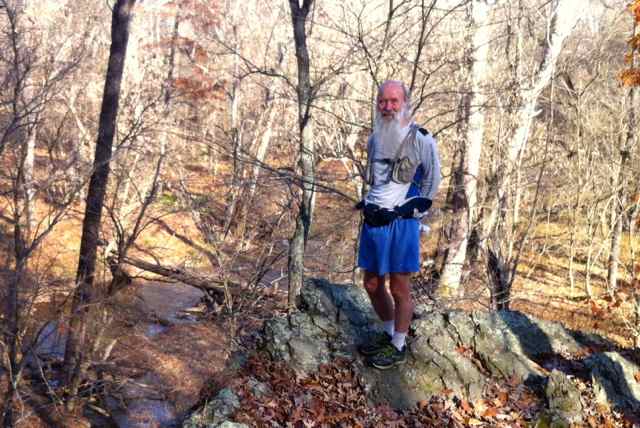 |
- Tuesday, November 26, 2013 at 05:12:43 (EST)
J. D. WIlliams's book The Compleat Stragegyst: Being a Primer on the Theory of Games of Strategy (1954, revised 1966) was formative to my thinking when I chanced upon a copy in the Austin Public Library and read it in the mid-1960s. It's full of cute, easy-to-understand, relevant examples of how to set up and solve two-person zero-sum "games" — quantitative situations where one player's gain is the other's loss. Lessons learned from Williams turn out to be valuable in countless life-contexts. The biggest lesson: it's possible to can think quantitatively about, model, and maybe derive an optimal solution when things are complicated and conflict-ridden. That's empowering.
And hurrah! — The Compeat Strategyst is available free, online ([1]). Rereading the "Preface to the First Edition" conveys some of John Williams's charming self-deprecating humor. For instance, on the conversation that the author's colleagues had which led to the decision to write the book:
Not recognizing that the discussion had reached a reasonable and natural stopping point, the group went on to nominate someone to write the book. After they coursed far and wide, and discussed many fine, though oblivious, candidates, it was anticlimactic to find myself chosen. The qualifications which won, or lost, the election are possibly worth enumerating: (1) I was at hand, and available; it is always immediately evident to research workers that an administrator is available. (2) While associated for some years, sympathetically, with the field of Game Theory, I was a compete ignoramus regarding most of its highly technical aspects; and I would probably not learn enough of these while writing the book to contaminate seriously the message that should be transmitted. (3) I was admirably situated, both organizationally and because of a natural bent to conserve energy, to call freely on my colleagues for aid and counsel; and the thus-shared burden would be more tolerable to all.
Echoes of Jerome K. Jerome's style in Three Men in a Boat! Williams continues to describe the goals of his book, including the dream that, "We believe it possible that Game Theory, as it develops — or something like it — may become an important concept and force in many phases of life." Alas, for most folks, that probably hasn't happened yet. Maybe some day!
(cf. MinimaxStrategy (1999-09-05), DippyHeuristics (2005-08-16), ...)
- Monday, November 25, 2013 at 04:37:20 (EST)
~3.8 mi @ ~8.8 min/mi
The old thrift-store shorts have become too large and start slipping down every lap — oops! — but fortunately for all the lights are out at the University of Maryland track, as a crescent moon sets and a young couple walks the outer lanes in the gloom. Six 800m repeats (with half-lap walks to recover between) yield splits of 3:48 + 3:41 + 3:40 + 3:43 + 3:40 + 3:32 (!). Son Robin runs steadily, then accompanies me to Marathon Deli for greasy salty French fries. See Runkeeper and/or Garmin for boring GPS oval trackfile maps.
- Sunday, November 24, 2013 at 06:21:45 (EST)
The Fall 2013 issue of Inquiring Mind includes "Dance & Sit—A Conversation with Pir Shabda Kahn". Kahn is a Sufi with some rather mystical notions but who also offers fascinating ideas. For instance, he suggests:
... The work of the Sufi is to be able to keep one's rhythm throughout life's conditions and to be in tune with the Infinite. In other words, an awakened being is a being whose condition is no longer based on circumstance.
And at the end of the interview there's a lovely new mantra, worth recalling and repeating during stressful times:
| This is how it is right now. |
(cf. Softening into Experience (2012-11-12), This (2013-03-09), ...)
- Saturday, November 23, 2013 at 11:08:10 (EST)
The 1984 sf movie The Last Starfighter was rather ahead of its time in a variety of elements. Some of the banter between characters has evolved into household words — in my household, anyway — such as the exchange between the protagonist, young earthling Alex, and his cheerful alien assistant Grig who tells Alex that a sneak attack has killed a large number of their compatriots:
Alex: You mean they're dead?
Grig: Death is a primitive concept; I prefer to think of them as battling evil, in another dimension.
Alex: In another dimension? How many are left?
Grig: Including yourself?
Alex: Yeah.
Grig: One!
It's that "Including yourself?" question-in-response-to-the-question that gives the answer such charm ...
- Friday, November 22, 2013 at 04:17:05 (EST)
~3.5 miles @ ~12.5 min/mi
| Begin at the end: Mary Ewell & I do a late lunch of eggplant and tofu, Chinese food at the Jade Rabbit -- yum! Then rewind past a mini-hike-tour of brush-overgrown statuary at the National Park Seminary. Pause for photo ops. Before that, run a brisk 5k along Rock Creek Trail from just inside the Beltway downstream to East-West Hwy and back, past friendly cyclists and dog-walkers. Start with a stroll through autumn leaves down Ireland Dr to the creek valley. Throughout, enjoy wonderful conversation and shared memories of past races. Thank you, Mary! Runkeeper and Garmin tell the tale of distance, pace, and route. | 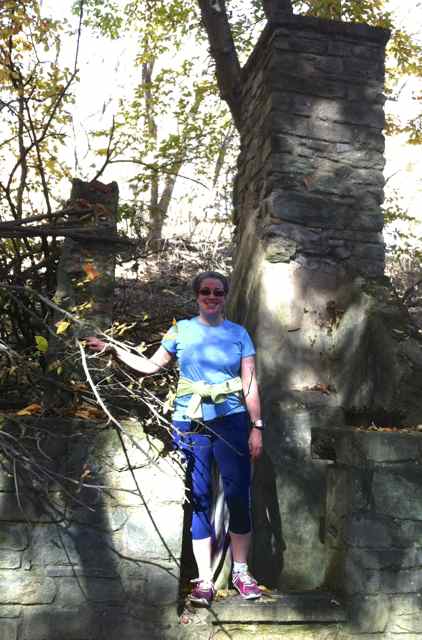 |
- Thursday, November 21, 2013 at 05:13:35 (EST)
If everything is temporary, in flux, contingent on other things ...
If "I, me, mine" are entirely illusion ...
If all judgment is false, and there is neither better nor worse ...
If the universe is one, and individual parts don't exist ...
Then, what reason can there be ...
For caring ...
For one another ...
For the earth ...
For the cosmos ...
Why practice loving-kindness ...
Or obey any rules at all?
Hmmmmm ... |
- Wednesday, November 20, 2013 at 06:17:10 (EST)
~12 miles @ ~15 min/mi
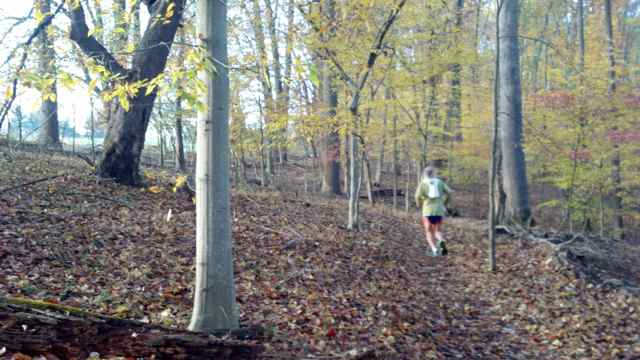 | "We need to carry a bucket of blue paint," I tell Barry Smith as we trot along Muddy Branch Trail. "Then we wouldn't go off course -- by definition!" Heading downstream we miss the blue blazes and lose our way three times; on the return trip we go astray only once. The path, as Barry points out, is both muddy and branching. Clouds reflect lovely in "Lake Placid" as we begin at sunrise. Soon autumn leaves shine bright. Small herds of deer amble through the brush. |
| Today is a training trek for the Stone Mill 50 miler in a fortnight. Barry says, "You won't remember this," and tells the story of his fall during a training expedition on the Appalachian Trail for the 2006 JFK 50 Miler. He strains a hamstring muscle and is lying on the ground, and as he tells it (perhaps with poetic exaggeration) other runners jump over him or complain that he's in their way. According to Barry, I stop and ask if he needs help. At the time we don't know each other. I don't remember it. Hmmmmmm! Runkeeper awards bonus distance for unknown reasons, and says we do ~12.7 miles. The Garmin says it's only an ~11.8 mile trek. Barry's GPS reads a similar number to my Garmin, so he runs an extra couple of blocks to make it a solid 12 for his logbook. | 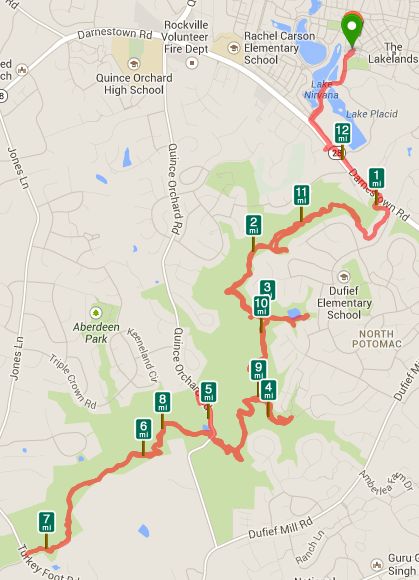 |
- Tuesday, November 19, 2013 at 04:30:18 (EST)
More than a year ago, neighbor-friend-statistician Doug Reingold lent me his copy of E. T. Jaynes's textbook Probability Theory: The Logic of Science. Thick as a brick, it sat by my bed for months until I skimmed bits of it and immediately saw how good it was. Doug has his copy back now and mine has replaced it in the pile. It's still mostly unread, alas, but at least the clock is ticking slower now!
Instead of a review, therefore, two memorable clippings from magician-mathematician Persi Diaconis's 2004 review "A Frequentist Does This, A Bayesian That" in the SIAM News:
The most interesting parts of the book are its constant focus on foundational aspects. We see far too little of this in our teaching and even less in applications. Jaynes doesn't let us get away without thinking. There are sermons on reality versus models, a whole chapter on paradoxes of probability theory and another on principles and pathologies of orthodox statistics. He is always questioning (and answering his own questions): What does it all mean? Does this make sense?
And Diaconis concludes:
There are many places in which I want to yell at him. He's so full of himself. That's what makes the book so terrific. It's the real thing — the best introduction to Bayesian statistics that I know. Go take a look for yourself.
Good advice, which I promise to take some day (prior probability = 0.8).
(cf. Statistics - A Bayesian Perspective (2010-08-13), Introduction to Bayesian Statistics (2010-11-20), ...)
- Monday, November 18, 2013 at 04:26:24 (EST)
Thich Nhat Hanh — Buddhist monk, writer, teacher, peace activist — is also rather a mystic. His little 1993 book The Blooming of a Lotus: Guided Meditation Exercises for Healing and Transformation definitely goes into dimensions that aren't grounded in (what I think of as) reality. But there are lovely poetic passages, and the 34 exercises and commentaries include some which might be quite useful, as speedwork and hillwork sometimes are for runners. For starters, in the introduction there's the cute footnote-metaphor of how to think about ringing a bell for meditation:
We never say "strike" the bell, because for us the bell is a friend who can wake us up to full understanding. We say "invite" the bell, meaning invite the bell to sound.
And a few pages later, concerning what to do when meditating:
"You only need to sit" is an exhortation of Tao Dong (Soto) meditation. It means that you should sit without waiting for a miracle—and that includes the miracle of enlightenment. If you sit always in expectation you cannot be in contact with or enjoy the present moment, which always contains the whole of life. Sit in this context means to sit in an awakened way, in a relaxed way, with your mind awake, calm, and clear. Only this can be called sitting, and it takes training and practice.
And for one more example, in Exercise 16 there's the brilliant thought of noticing and being thankful for what's absent:
A neutral feeling is neither pleasant nor painful. But when such feelings are recognized in mindfulness, they usually become pleasant feelings. This is one of the benefits of insight meditation. When you have a toothache the feeling is very unpleasant, and when you do not have a toothache you usually have a neutral feeling. However, if you can be mindful of the nontoothache, the nontoothache will become a feeling of peace and joy. Mindfulness gives rise to and nourishes happiness.
Hmmmm ... and at every moment there are so many unpleasant feelings to be mindful of that aren't present! Nonstop-nirvana?
(cf. Eat the Orange (2004-11-28), Laundromat Surprises (2009-03-02), Breath as Vehicle (2009-06-17), ...)
- Sunday, November 17, 2013 at 14:31:15 (EST)

Sunrise at The Lakelands in Gaithersburg, on 2 November 2013: Barry Smith spies clouds reflected in a pond named Lake Placid. "You have to take that picture!" he commands.
- Saturday, November 16, 2013 at 03:50:50 (EST)
Six years ago in the New Yorker Anthony Lane wrote a memorable essay, "Candid Camera", subtitled "The Cult of Leica". It's an exaggerated but delightful song of praise and includes the wonderful quote from Ralph Gibson:
"More great photographs have been made with a Leica and a 50-mm. lens than with any other combination in the history of photography," Gibson said to me. He advised Leica beginners to use nothing except that standard lens for two or three years, so as to ease themselves into the swing of the thing: "What you learn you can then apply to all the other lengths."
And yes, it's hype and mystique and mojo. As photography advisor/reviewer Ken Rockwell says rather less poetically, "The camera's only job is to get out of the way of making photographs." What counts is composition and timing, understanding and exposure, and above all focus, as Rockwell emphasizes in "The Secret: What Makes a Great Photo". The camera doesn't matter — within limits!
- Friday, November 15, 2013 at 04:39:51 (EST)
Start with Monty Python's Life of Brian. Add a tablespoon of Fight Club and half a cup of Forrest Gump. Blend in a pint of Stranger in a Strange Land. Bake for 400+ pages. That's Lamb, a novel (2002) by Christopher Moore. It's subtitled "The Gospel According to Biff, Christ's Childhood Pal". By turns, Lamb is silly, naughty, theologically naïve, and distressingly predictable. What it's not, alas, is funny or loving. The Pythons managed the mock-Jesus schtick more cleverly and compactly, with genuine soul and sympathetic spirit.
Unlike its crispy archetypes, Lamb's prose stumbles. Moore's protagonist invents coffee (with cream and sugar), matches, and pencils. Nudge, nudge, wink, wink. And? Perhaps in another medium, Lamb could have worked — graphic novel, anime, campfire story. On paper? Not so much ...
(cf. Cut the Volume (2004-03-05), Forrest Gump (2007-05-14), Stranger in a Strange Land (2009-12-11), ...)
- Thursday, November 14, 2013 at 04:28:51 (EST)
A tremendously important psychological tendency has an unfortunately opaque name: Fundamental Attribution Error. Briefly, the FAE says:
- when other people do something, especially something I don't like, they do it deliberately, by choice, because of their personality, with malice, etc.; but
- when I do something unworthy, it's because of circumstances, the situation, external reasons.
Quite an asymmetry in the blame game. As voluptuous cartoon character Jessica Rabbit says in the film Who Framed Roger Rabbit, "I'm not bad. I'm just drawn that way!"
(cf. SelectionEffects (1999-05-11), Impute Motives (2009-03-18), 2013-03-05 - McLean Loops, ...; and re FAE in politics, see Edsall who cites Tetlock & Mitchell, ...)
- Wednesday, November 13, 2013 at 04:37:08 (EST)
| After a Saturday morning run together along the Seneca Creek Greenway Trail, comrade Barry Smith drops me off in downtown Silver Spring to pick up apples and yogurt at the farmers market. It's a frigid day, and I miss the #5 bus home by a few seconds. So I go into the McDonalds nearby, and start studying the $1 menu, still wearing running shorts, windbreaker, and hydration backpack. A kind gentleman comes up to me and tries to press a couple of dollar bills into my hand. Do I really look that homeless?
(I thank him and suggest he donate the money to somebody who needs it more.) | 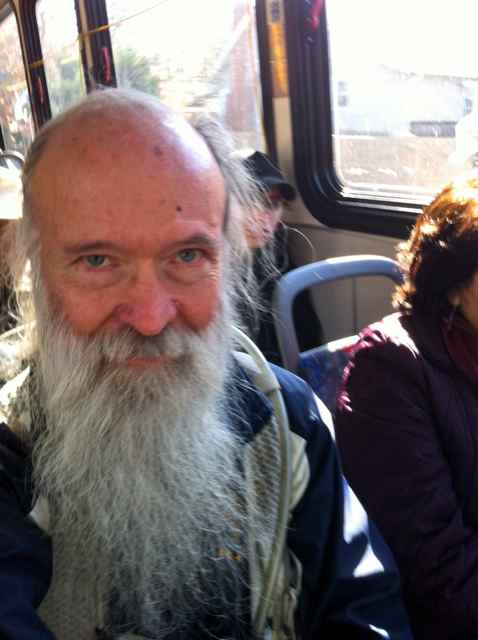 |
- Monday, November 11, 2013 at 20:10:53 (EST)
~3 miles @ ~10.5 min/mi
"Car back!" is the chorus on a foggy dark Halloween morning as the usual gang — Amber, David, Kerry, Kristin — starts at 0630 for a pre-work-day ramble around the Pimmit Hills 'hood, accompanied by jokes about transcranial low-voltage brain stimulation, a mini-review Master and Commander, anecdotes of recent races, etc. At journey's end both Kristin and I actually manage (barely!) to control our obsessive-compulsive tendency to do "just a few steps more" and push the distance up to the next integer value. "2.97 miles" is what Runkeeper records. Enough!
- Sunday, November 10, 2013 at 11:21:51 (EST)
The "Barkley Marathons" is an extraordinarily difficult 100 mile trail run, five 20-mile laps through the rugged terrain of the Frozen Head State Park in Tennessee. In 2013 two people — Nick Hollon and Travis Wildeboer — succeeded in finishing it within the 60 hour time limit. They were only the 13th and 14th to do so since the event began in 1986. Race Director Gary Cantrell aka "Lazarus Lake" wrote a poem about it:
The conditions this year were impossible,
yet there were finishers.
Nick Hollon, and Travis Wildeboer,
each making their third attempt,
made a lie of human limitation...
at a price.
To be at the yellow gate after a Barkley finish
must be experienced to be understood.
I felt like a child at the grownups table...
listening in...
13 and 14, collapsed in their chairs, bundled in blankets,
talking with the others who had been where they had been;
in the rarified air of loops 4 and 5.
talking of experiences I can only imagine
with a combination of awe and shuddering fear
their tales are harrowing ones.
of numbing fatigue, desperate climbs and heart stopping descents,
of constant fear and uncertainty
of a time limit that is always just behind them,
when a single error could bring down everything they had worked for.
I felt, at once,
both humbled...
and elevated...
at this glimpse into the thoughts of those
who have been where no man can go
and done what no man can do.
it is hard to explain,
but seeing the barkley done makes it seem more impossible.
not less. |
(cf. Tales from Out There (2010-05-11), Big Stick (2010-05-18), Hardness Scales (2011-01-05), ...)
- Saturday, November 09, 2013 at 06:15:04 (EST)
~32 miles @ ~15 min/mi
 | Stephanie Fonda spots a brilliant orange Araneus marmoreus, aka marbled orb-weaver spider, as it crawls along a rocky road in the Green Ridge State Forest. At this point — mile ~22 of the "Fire on the Mountain" 50k race — Stephanie and I have been crawling likewise for half a dozen hours. We pause to empathize with the arachnid. Today is a day of beautiful scenery, steep slopes, slippery mud, rocks and roots, helpful volunteers, perfect weather, and splendid conversation in the woods of western Maryland. What's not to love? |
| Our morning begins about 0300 — rise and shine! — as we gather gear and rendezvous for the two-hour drive to the race. Mike Edwards gives me a lift to Stephanie's home, where we pile gear into the trunk of her car and head out at 4am. It's an uneventful journey, past multiple deer resting in peace by the side of the highway, victims of unfortunate mating season encounters. Once off the major roads we meander through the forest on gravel-and-dirt byways, park at the finish area, pick up our numbers and race packets, and gird our loins for the day ahead. Then it's time to pile into big yellow school buses and bounce along another 45 minutes to the starting line. Stephanie naps while I try to peer through foggy windows. We arrive at the scenic overlook and marvel at the meandering Potomac River below. Good friends from past ultramarathons greet us. | 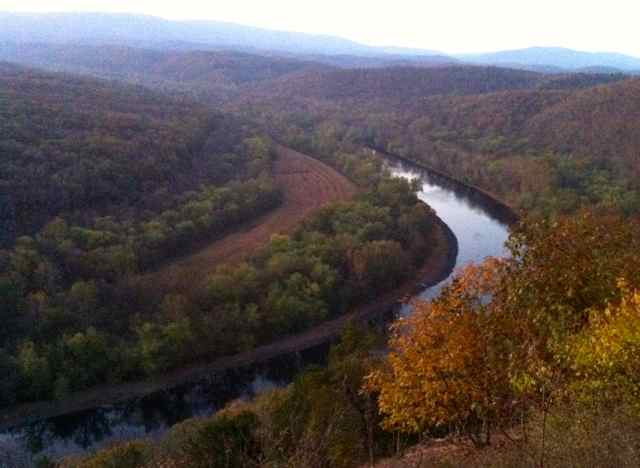 |
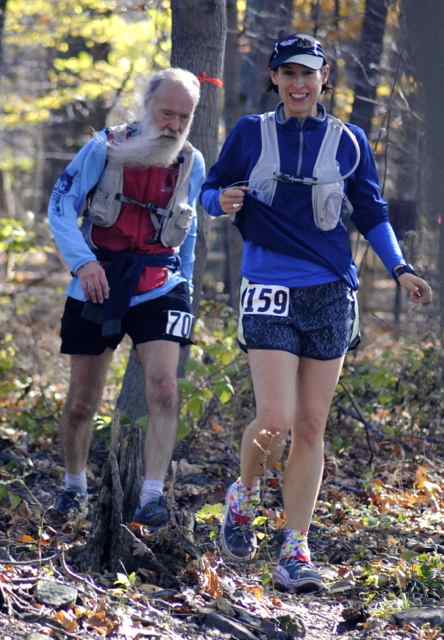 | Stephanie and I capture my favorite location — DFL! — during the initial mile. The course takes us down treacherous declines to stream valleys, across creeks several dozen times, and back up the steep sides of ridges via leaf-strewn pathways. Some of the trails are so narrow and sloping that we fear slipping into the valleys below. At one point there's a muddy chute that some runners are sitting down to navigate. We cling to saplings and hug trees to make our way. | 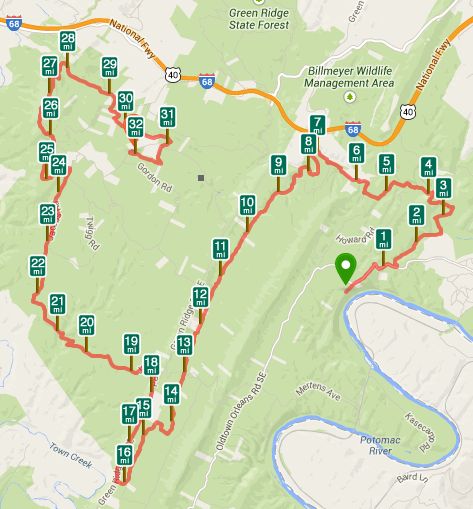 |
| At mile 16 we climb a steep hill to the mid-course aid station, with dramatic views of the valleys below. Kind people refill our hydration packs and offer us a huge variety of goodies. I fill my pockets with M&M candies and creme sandwich cookies. Stephanie snags a handful of peanut butter and jelly sandwiches. Then off we go for half a dozen miles along one-lane dirt-and-gravel country roads, stepping aside for occasional cars to pass by. During the first few miles of FotM today I feared that we would miss the cutoffs, but now it's clear that we're doing fine. Sporadically I recompute our required pace, e.g., "We could walk the rest of the way at 20 minutes/mile!" and a bit later, "Now we only need to average 25 min/mi", etc. We catch up with buddy Anton Struntz, whose yellow-and-orange outfit today makes him look a bit like a giant piece of candy corn. Anton is cheerful as always, pressing onward through injury and aiming to finish comfortably. (He does.) | 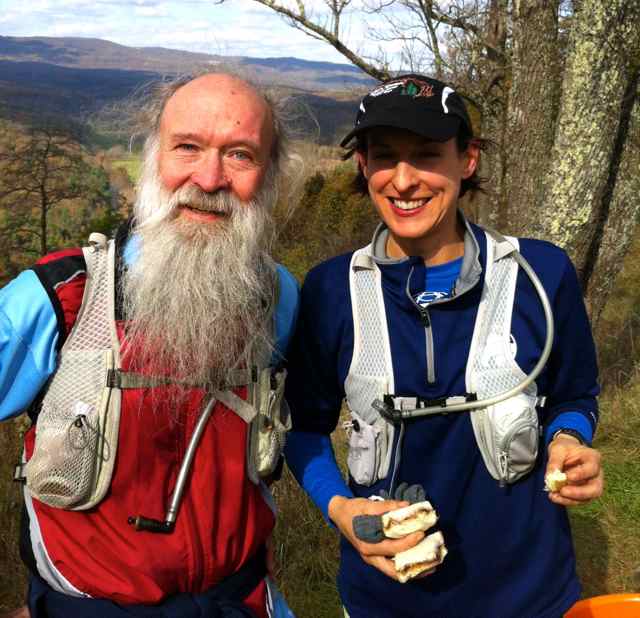 |
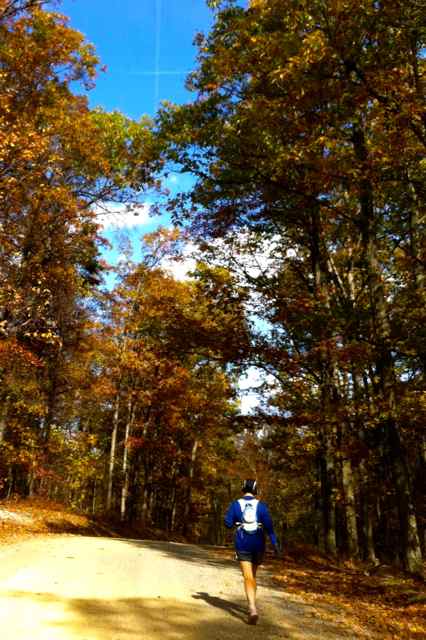 | At one point contrails from two high-flying jets cross at a 90° angle above the course. We cruise at sub-12 min/mi for three miles in the middle part of the trek, but slow down to enjoy the final stretch once it's clear that we are safely within all time limits. Cheery runners pass us, including a memorable one in über-fluorescent pink jersey and black tights. We offer encouragement to the walking wounded whom we overtake. Approaching the race's end, a quarter-mile loop around the field where we parked before sunrise, we're handed split-wood sticks to toss onto the fire at the finish line. We smile for the cameras, snag medals and munchies, and enjoy complimentary coffee and strawberry smoothies from event sponsor Sheetz's van. I pose for photos with another bearded gentleman whose friends think we look alike. Stephanie changes into comfy clothes for the return trip; I sit on a thick towel. We pause at a McDonalds near Hagerstown that I remember from Boy Scout camping trip journeys. Diet Coke hits the spot today. Runkeeper data documents our route and pace. Official results put us in 93rd and 94th place of 103 finishers, at about 8:14, safely under the final 9 hour cutoff. Comrade Mike Edwards waits patiently, having arrived an hour earlier. It's a lovely day! | 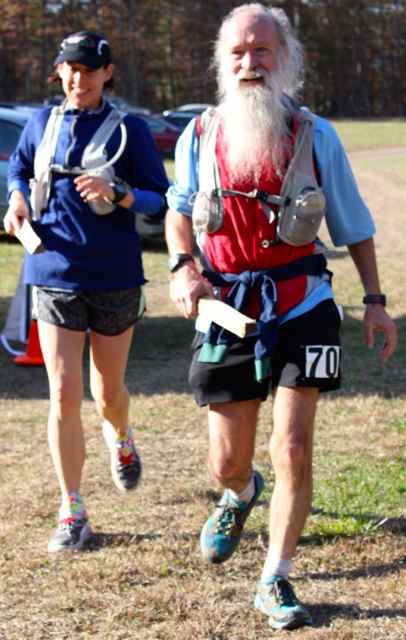 |
- Friday, November 08, 2013 at 04:24:36 (EST)
Recent chats with a dear friend suggest a brilliant one-bit femto-language in which to express two key concepts of life, love, and mindful awareness:
- 0 = nonattachment — no clinging, to self or externals — "Let It Go!"
- 1 = oneness — universal connection, the essential unity of all being — "We Are One!"
What more need be said?
(cf. My Religion (2000-11-06), Most Important (2002-05-16), The Meaning of Life (2008-07-24), This Is Water (2009-05-21), Core Buddhism (2011-10-17), Big Ideas (2012-05-20), O (2012-10-24), Help, Thanks, Wow (2013-02-25), ...)
- Tuesday, November 05, 2013 at 04:20:02 (EST)
~15 miles @ ~14 min/mi
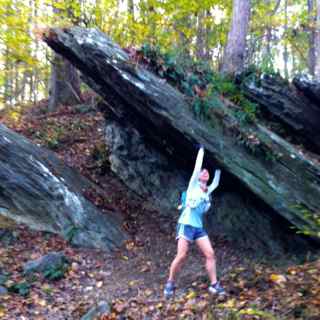 | Stephanie Fonda demonstrates the benefits of cross-training by lifting a rock beside Northwest Branch Trail. This Sunday morning we do a fun loop from the New Place, across Wheaton Regional Park, and down Northwest Branch Trail, over boulders and under the Beltway. We scare three big deer drinking from the stream and greet innumerable dog-walkers. When we reach New Hampshire Av we take Piney Branch Rd across University Blvd, pausing to buy a cup of coffee at La Pollera, a friendly hole-in-the-wall where chickens rotate slowly on a spit above glowing charcoal. The trek back to the start is via Sligo Creek Trail. Splendid conversation lifts our spirits throughout, and it's perfect prep for the Fire on the Mountain 50k in western Maryland next Sunday. Thank you, Stephanie! Runkeeper and Garmin GPS record the route. | 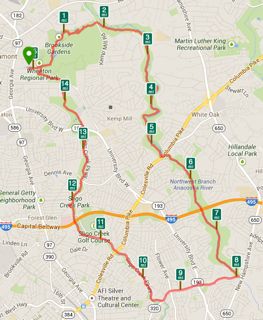 |
- Monday, November 04, 2013 at 04:06:30 (EST)
I envision my mind as brilliant
A sun, a supernova
And most of the time, I hide
To keep from blinding others
Or so I imagine
Yet could it be that
Huddled in my cave
I've already blinded myself? |
- Sunday, November 03, 2013 at 05:42:51 (EST)
Silly poetry, explicit examples, occasional minor anti-Frequentist rants: John K. Kruschke's textbook Doing Bayesian Data Analysis is a useful quick-start to an important set of methods for statistical analysis. Chapter 1 begins with a pep-talk Section 1.1, "Real People Can Read This Book", which gave me a chuckle when it said that the material is not aimed at "... the mythical being who has the previous training of a nuclear physicist and then decided to learn about Bayesian statistics." Hold the phone: I am that "mythical being"!
Kruschke's content is fine, but he had better not quit his day job (he's a professor at Indiana University) to become a bard. The best of his verses, perhaps, is Chapter 7's slightly suggestive:
You furtive posterior: coy distribution,
Alluring, curvaceous, evading solution,
Although I can see what you hint at is ample,
I'll settle for one representative sample. |
But maybe you have to be a Bayesian to appreciate it!
(cf. Statistics - A Bayesian Perspective (2010-08-13), Introduction to Bayesian Statistics (2010-11-20), ...)
- Saturday, November 02, 2013 at 17:34:38 (EDT)
~16 miles @ ~11.9 min/mi
"Good morning, Liz!" I shout at my neighbor at 7:10am as she brings in her newspaper, wearing her nightgown; her back is turned and she doesn't hear me. From home to Meadowbrook Stables takes almost 20 minutes, pushing the pace to arrive in time. Sandra "Sam" Yerkes and Gayatri Datta greet me, and we set off downstream. Packs of runners in training pass us, wearing bright colors. Peletons of spandex-clad cyclists zip by.
After the first mile Sam runs ahead while Gayatri and I take our time down Beach Dr. At the Broad Branch Rd gate we tag and turn back. I eat a pack of half a dozen Oreos, and Gayatri drinks coconut water and nibbles on figs. "What's that noise?" I ask Gayatri during the return trip. It's a flock of blackbirds, yammering as they rest in a tree. A pair of ladies are bent over, protecting a wooly bear caterpillar from being eaten by their tiny terrier, trying to move the furry critter off the street using a stick. Maybe they dislike touching wooly bears as much as I do, or used to?
Runkeeper and Garmin GPS record the run. Splits by the latter are 10:11 + 9:26 (racing to arrive on time) + 14:15 + 11:50 + 11:00 + 11:55 + 11:05 + 12:29 + 11:41 + 15:38 (latrine break) + 12:11 + 11:17 + 12:26 + 11:18 + 11:47 + 9:32 (solo sprint on the home stretch)
- Friday, November 01, 2013 at 04:10:31 (EDT)
From Day 88 of Rolf Gates and Katrina Kenison's Meditations from the Mat:
When we do feel lost or uncertain, drifting away from our practice, blocked from our own truth, it helps to remember that darkness and confusion, too, are part of the path. The hero's journey is a journey inward. Yoga is not a workout, it is a work in. In the Tao Te Ching, we read that the only real movement is return. And this is the point of spiritual practice: to make us teachable, to open our hearts and focus our awareness so that we can know what we already know, and be who we already are.
- Thursday, October 31, 2013 at 03:45:38 (EDT)
~62 miles @ ~17.3 min/mi
| DNF: Did Not Finish. Again, on the fourth attempt to run a 100 miler, expectation falls short in the face of Reality. But I stay open to the possibilities and do finally "run my age" in miles, and do reach ~100 kilometers, and do have a wonderful time trekking through Long Island's Rocky Point State Pine Barrens Preserve with Rayna Matsuno, dear friend, epidemiologist, and experienced ultrarunner. A few months ago Rayna learned of the inaugural Tesla Hertz Run, told me of it, and after patient effort snookered me into entering with the promise of her support. So between mile ~46 and midnight when I decide to call it a day, Rayna and I hike through the woods and discuss Bayesian statistics, the Game of Thrones fantasy saga, mindfulness, sensitivity vs. specificity of diagnostic medical tests, love, programming languages, yoga, Japanese slang, self-actualization, favorite movie quotes, and countless other topics including the meaning of life. As a pacer Rayna can't lead the way or carry gear for her runner, but she can assist in navigation and gently encourage the spirit. There is no way I could have gotten nearly as far without her gracious companionship and constant vigilance. And I feel great the next morning — no blisters, chafing, or significant soreness. Thank you, Rayna! And in spite of intermittent metatarsal pain the 18 hour journey truly is All Good — and I really am glowing in the photo that Rayna takes of me at mile ~15. | 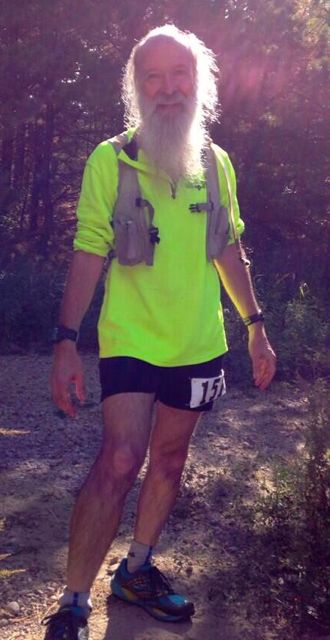 |
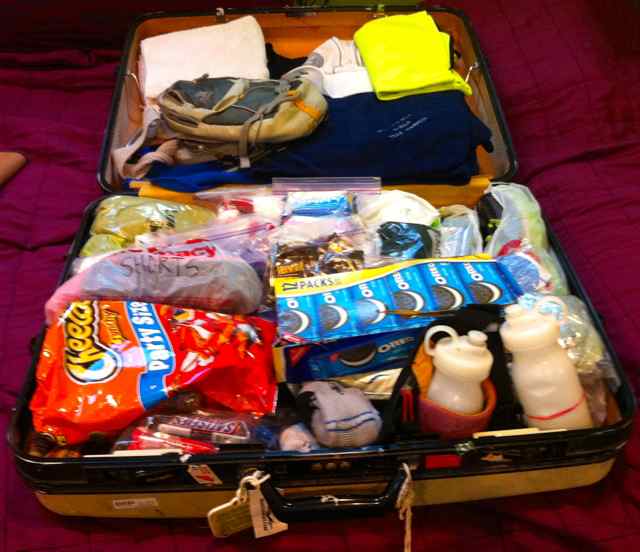 | My son Merle's mega-suitcase is an instant resource that I can draw upon every 2 hours 45 minutes when the THz's path takes me past the midpoint of the ~10.4 mile loop. Rayna and her buddy "K2" can almost set their watch by my appearances, as I steadily follow veteran Meredith Murphy for the first 30+ miles. She patiently answers my questions about her amazing Badwater experiences, racing and pacing. We discuss nutrition, shoes, our families, work, and more. It's so nice to make an unexpected and helpful new acquaintance. After the first three laps when Meredith pauses in the woods I feel strong and trot ahead, with her blessing. She goes on to finish the 50 miler. Whenever I see Rayna at our Aid-Station-in-a-Box she ultra-efficiently takes care of my needs. In turn I try to be coherent and direct. "Six gels and a Snickers candy bar, please!" ... or "Just some water and a package of Oreos!" ... or "I need a change of socks!" At mile 36 when that happens Rayna grabs a tiny towel and quickly massage-cleans my feet. She explains that it's crucial to prevent blisters. All I know is that it feels great! (Thanks again, Rayna!) I advise K2, "You must ask her to do this for you!" |
| As part of being a good trail runner I pick up litter whenever I can. At one point along the THz route there's a bottlecap from a local brewery, featuring a mystical all-seeing eye. Is it associated with Nikolai Tesla's nearby Shoreham laboratory? Did Tesla's experiments in electromagnetic radiation cause any strange phenomena among the wildlife? A few days after I get home I find what seems to be a deer tick on my shoulder. Will its bite give me super-powers, or simply Lyme Disease? (My doctor prescribes a dose of doxycycline in case it's the latter.) As night falls I see little emerald-green gems sparkling by the path. Hallucination? Ah no — upon closer inspection they turn into brown spiders, their beady eyes retroreflecting light back to my headlamp. Kind friend Stephanie Fonda, who is running a night 50 mile experiment and pacing her comrade Marshall Porterfield, tells in her THz race report of seeing the same "glinty-eyed wood spiders". And then there's the insect battle that I lose, in late afternoon at the mid-course aid station, when the bowl of candy corn is swarming with yellow-jackets. I reach in to grab a handful (of corn) and come out with just one (wasp). It stings my left little finger — ouch! The pain only distracts me for a lap or two, but the swelling lasts a couple of days. |  |
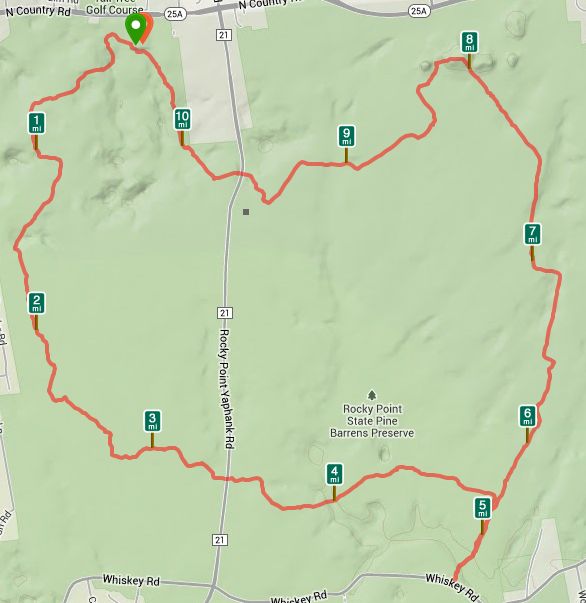 | The inaugural 2013 Tesla Hertz run is the brainchild of Vinny and Nichole Cappadora. They do a splendid job, as do all the cheery race associates I meet. The loop through the woods is well-designed, and strangely enough not at all boring to navigate. Helpful volunteers assist runners at the only major hazard, where the trail crosses Rocky Point-Yaphank Road. After a circuit or two, in fact, certain corners and features become old friends: the sandy hill, the narrow channel, the mountain bike path crossings, the rusty ironwork protruding from the concrete pillars that perhaps once supported a high-tension power line. Not to mention the high school football field where the amplified announcer calls the plays of an invisible game, which is followed in the evening by a party. Homecoming, perhaps? And there's the creeky old tree that lies aslant through the fork of its neighbor, and groans as the wind blows to shift it slightly, like a bow across a violin's strings. Every time I pass by it I feel a chill and remember Stephanie Fonda's term "widow-maker" for a falling branch. Fortunately, nothing untoward happens. The post-grunge song Machinehead by Bush runs through my noggin for much of the day, as does Tubthumping by Chumbawamba. As its chorus repeats, "I get knocked down but I get up again / You're never going to keep me down." Today, however, there are stumbles but no falls. |
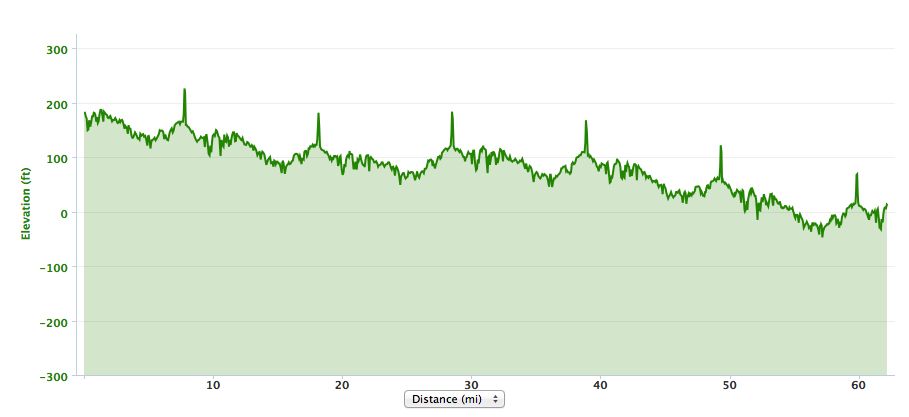 Nikolai Tesla's experiments may had some nonbiological effects on the locality. To save the phone battery I only record the sixth (and final) lap of the adventure using Runkeeper. But the Garmin GPS captures the entire distance and the full 18 hours. As the graph shows, in violation of the conservation laws of gravitational potential energy, every lap is ~40 feet lower than the one before. Is it a magical Penrose Staircase? A warping of the spacetime continuum? Or perhaps, more mundanely, is the barometric altitude correction fooled by an incoming high-pressure cell during the race? Hmmmm ... |
(cf. 2010-05-15 - Half Massanutten Mountain Trails, 2012-04-07 - Philly 100 Endurance Run, 2013-04-27 - C-and-O Canal 100 DNF, ...)
- Tuesday, October 29, 2013 at 04:54:42 (EDT)
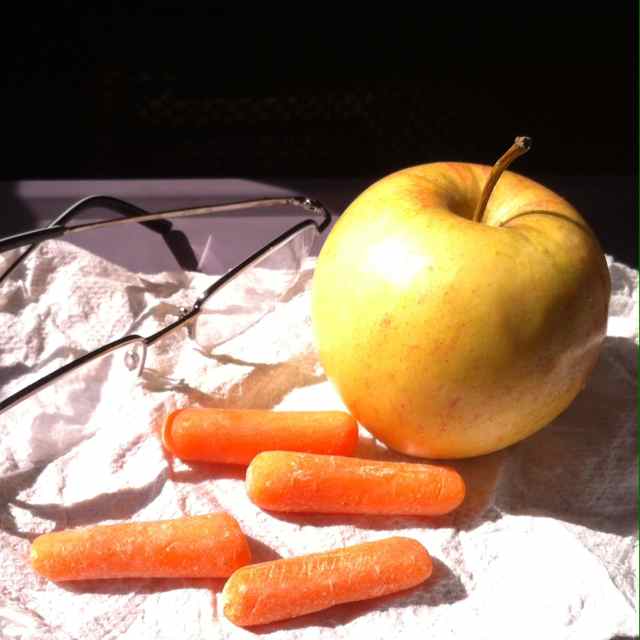
(taken on the Amtrak train home from the Tesla-Hertz 100 miler, October 2013; non-glasses components thanks to Rayna Matsuno)
- Monday, October 28, 2013 at 04:11:22 (EDT)
George R. R. Martin's Game of Thrones is a soap opera, a movie script, a romp, an orgy, and a delight to read. Dear friend Rayna Matsuno recommended the video, and after watching the first season I began the book. (The two are virtually identical.) About a seventh of the way into its 800+ pages comes an explanation of why literacy is so crucial. Tyrion Lannister, dwarf from a noble family, explains why he reads so much:
"... My legs are short and twisted, and I walk with difficulty. I require a special saddle to keep from falling off my horse. A saddle of my own design, you may be interested to know. It was either that or ride a pony. My arms are strong enough, but again, too short. I will never make a swordsman. Had I been born a peasant, they might have left me out to die, or sold me to some slaver's grotesquerie. Alas, I was born a Lannister of Casterly Rock, and the grotesqueries are all the poorer. Things are expected of me. My father was the Hand of the King for twenty years. My brother later killed that very same king, as it turns out, but life is full of these little ironies. My sister married the new king and my repulsive nephew will be king after him. I must do my part for the honor of my House, wouldn't you agree? Yet how? Well, my legs may be too small for my body, but my head is too large, although I prefer to think it is just large enough for my mind. I have a realistic grasp of my own strengths and weaknesses. My mind is my weapon. My brother has his sword, King Robert has his warhammer, and I have my mind . . . and a mind needs books as a sword needs a whetstone, if it is to keep its edge." Tyrion tapped the leather cover of the book. "That's why I read so much, Jon Snow."
- Sunday, October 27, 2013 at 02:33:27 (EDT)
Thoughtful advice in the chapter "How to Continue" of Andrew Weiss's Beginning Mindfulness:
When in doubt, go back to basics. Remember your breath is your anchor, and simple, honest mindfulness of breathing can lead you right back to the present moment. Don't get caught up in technique. Remember that the instructions and techniques, and even the words of great teachers, are no more than a finger pointing at the moon: Always go for the moon.
- Saturday, October 26, 2013 at 07:53:48 (EDT)
~7 miles @ ~13 min/mi
| New sweatband, birthday gift from my brother Keith, is helpful today as Barry Smith leads a warm & humid afternoon trek from his home, up Sligo Creek, and across to Northwest Branch Trail. Unlike last Sunday (2013-09-29 - Northwest Branch and Sligo Creek with Barry) this time we go downstream to Colesville Rd. After a short additional scramble over slippery leaves and rugged rocks, we turn back, take the sidewalk along Colesville to Blair HS, run a lap on the oval asphalt track, and then continue to Sligo Creek Trail again, thence upstream back to our start --- whew! Runkeeper and Garmin GPS show the path and pace. | 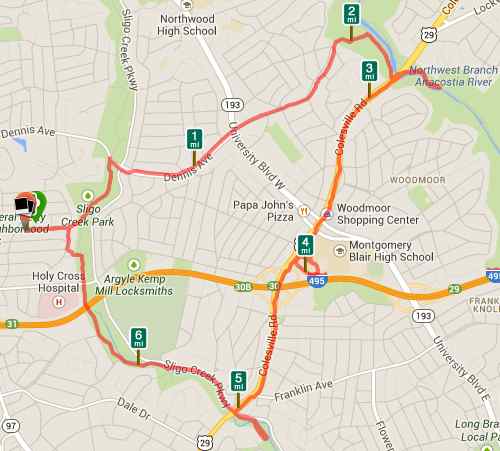 |
- Friday, October 25, 2013 at 04:12:04 (EDT)
Daniel Kahneman's book Thinking, Fast and Slow has a great ending, a fine middle, and a weak beginning. The "Conclusions" chapter summarizes his key points quite nicely in terms of "two fictitious characters, two species, and two selves":
- The two characters are "System 1" and "System 2", shorthand labels for the major types of mental activity. System 1 produces intuitive answers quickly, effortlessly, and automatically; System 2 is slow, gets tired, and handles complex chains of logic. Both are deeply flawed in many ways, and both have great strengths. System 1 focuses on what is visible and vivid, tends to be overconfident in its judgments, and gives excellent approximate answers to common questions in regular, stable domains where feedback is good. System 2 raises warning flags, focuses attention, and suppresses bad impulses.
- The two species are "Econs" and "Humans". Econs are rational actors, always maximize utility, and form the ideal citizens in an anarcho-capitalist libertarian utopia. Humans make mistakes, are swayed by emotions and con men, and need protection from themselves at times.
- The two selves are the "experiencing self" and the "remembering self". The experiencing self lives momemt-by-moment and is largely System 1; the remembering self looks back, keeps score, makes choices, and is primarily run by System 2. In remembering, people tend to neglect duration and focus on the peak and the final moments of an episode. We prefer a short period of intense joy over a long period of moderate happiness, and fear brief intense pain more than a longer span of moderate suffering. And we really love happy endings. Is that way of thinking right or wrong? In either case, it poses fascinatingly unanswerable philosophical questions of how to live.
Kahneman's flaws? The book is slow and often feels padded. The evidence cited from psychological experiments is often weak, possibly wrong. Statistics are skimpy. And every chapter ends with silly little make-believe quotes. Is that a deliberate device to deceive the System 1 anecdote-prone part of the reader's brain? If so, it's a disappointing trick that doesn't work well and reduces credibility.
Happier tidbits from the book? There are many. One of the best is in Chapter 17 ("Regression to the Mean"):
- success = talent + luck
- great success = a little more talent + a lot of luck
There's also the excellent rule for correcting one's intuitive predictions in Chapter 18 ("Taming Intuitive Predictions"). To forecast something in a specific case — an individual person's height, a particular company's growth next year, the score on day 2 of a golf tournament by the leader on day 1, whatever — follow these four steps:
- begin with an estimate of the baseline — the general average over the appropriate population of the quantity to be predicted, without taking into account any information about the individual involved
- estimate the intuitive best answer for the specific case based on additional known information for that individual
- estimate the correlation between the known information about the specific case and the quantity to be predicted — a fraction ranging between 0 (perfectly uncorrelated) to 1 (perfectly correlated)
- starting with the baseline value (1), move toward the intuitive answer (2) — but only by the fraction given by the correlation (3)
And there's the solid, valuable argument in Chapter 21 ("Intuitions vs. Formulas") in favor of ridiculously simple rules of thumb. Based on Robyn Dawes's article, "The Robust Beauty of Improper Linear Models in Decision Making", Kahneman presents the formula for predicting marital stability:
| frequency of lovemaking minus frequency of quarrels |
Positive numbers mean a healthy marrige. A similar rough formula gives the Apgar Score to assess newborn baby health. Expert human judgment, based on intuitive appraisal of a multitude of factors, tends to be much worse than the results of simple additive formulas, as Philip Tetlock's Expert Political Judgment showed in other realms.
Thinking, Fast and Slow is a best-seller (talent + luck) that appeals (System 1) but also persuades (System 2). Good reading.
- Thursday, October 24, 2013 at 04:19:04 (EDT)
~7 miles @ ~9.5 min/mi
| Venus gleams low in the west and gloom deepens under the trees along Northwest Branch Trail. During mile 2 it's hard to see the bumpy asphalt through glowing afterimage-like blobs (ocular migraine effect?) but eventually they fade. The steep hill climb to Oakwood Dr is at paved path's end just inside the Beltway, past a cluster of girls wearing headlamps (a cross-country team?). The return trip is via sidewalks along busy New Hampshire Av & University Blvd, dodging cars at crosswalks and driveways. Runkeeper and Garmin GPS record distance and pace. | 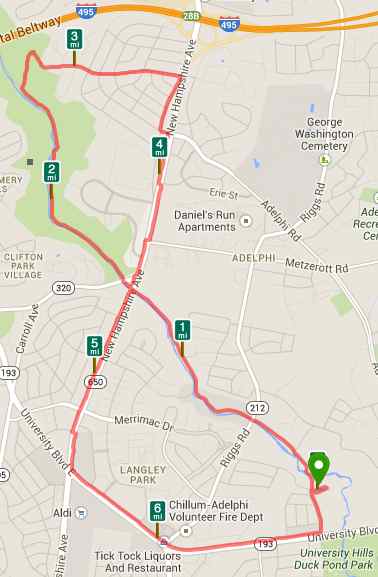 |
- Wednesday, October 23, 2013 at 18:09:49 (EDT)

- Tuesday, October 22, 2013 at 04:13:01 (EDT)
~2 miles @ ~12.5 min/mi
Glowing clouds at dawn let Jupiter peek through but not much more. Colleagues David, Kerry, and Kristin gather at the loading dock and set off at 0630 in a neighborhood circuit, but Kristin is still recovering from injury — so after ~1.5 miles she and I let the rest run onward while we walk back. I insist on leaving my GPS on until it shows 2.0 miles, as per Runkeeper; Garmin concurs.
- Monday, October 21, 2013 at 04:07:49 (EDT)
Peter Singer — Australian, Utilitarian, Princeton philosopher — has long been famous in the animal rights world for his arguments against cruelty associated with carnivorism. His book The Life You Can Save focuses on human suffering and explores arguments in favor of greatly increased charity toward those in the worst corners of the world, the poor and sick mainly located in Africa, Asia, and less-developed areas of the Americas.
It's a fast-reading but complex and multifaceted discussion, convincing in many parts, shaky in others. From near the beginning of the book Singer mixes intellectual fallacies, such as appeals to emotion, with solid logic and fact. Wealthy people — meaning virtually all of us who may read this — throw away money on frills, in Singer's judgment, like bottled water, fancy cars, spectator sports, etc. Yes, we enjoy them. But we should, Singer contends, throttle back on such spending in order to donate several percent of our income to organizations like Oxfam that efficiently direct resources toward projects that save lives and lift people out of poverty.
Hard to argue with some of that. Singer's heart-wrenching examples of suffering are unforgettable. And the quantitative estimates of how much it costs per death prevented, per major medical problem repaired, etc. all add weight to the case. It turns out, for instance, that factoring in all the probabilities and overhead, most anti-disease campaigns are only a few tens of dollars per life saved — more than the pennies that are sometimes advertised, yet still shockingly low.
But there are weaknesses. Singer's arguments against (most) saving for retirement and against (much) charity toward local higher education and hospitals, etc., are (largely) questionable. Likewise his attempts to compute a sliding-scale formula for the appropriate percentage that well-off people should donate from their income and accumulated wealth. That doesn't mean he's wrong; it does suggest that more careful thinking is needed in those areas. (His unstated bottom line judgment: tithing isn't too far off. More would be better, if you're rich enough to afford it.)
And the key questions that Peter Singer tries to explore — fairness and inequality and obligation — remain tough challenges. The Life You Can Save is a flawed but unblinking look into those areas of ethics and social morality.
(cf. EstateTax (2005-05-06), Philanthropy and Charity (2010-03-28), ...)
- Sunday, October 20, 2013 at 16:25:49 (EDT)
~12 miles @ ~12.2 min/mi
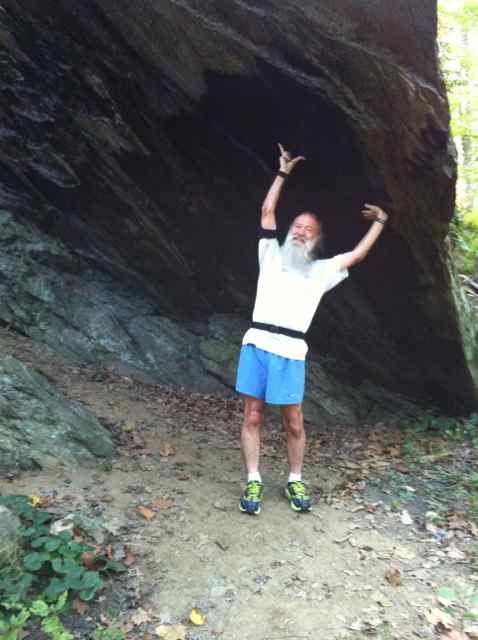 | Sunday afternoon: trot to Barry Smith's home, then up Northwest Branch Trail and back via Kemp Mill and Sligo Creek. Dog-walkers along Northwest Branch are out in force. At the big rock I practice cross-training by faux-lifting it. Barry shares an image on Facebook and reports that it gets more "Like" clicks than anything else he has posted. We follow Kemp Mill to Arcola rather than take the Wheaton Regional Park trail. A svelte girl at University Blvd in black two-piece running garb encourages us to push the pace. To reach the water fountain at the Sligo-Dennis Rec Center I sprint a fast quarter mile. Runkeeper and Garmin generally concur. |
- Saturday, October 19, 2013 at 15:08:27 (EDT)
From Day 63 of Meditations from the Mat by Rolf Gates and Katrina Kenison:
If we are to find lasting happiness, we must not only clean up our rooms but clean up our thoughts as well. Fortunately, that is precisely what the practice of yoga is all about. To begin, we let go. We let go of our thoughts, our old scripts, our expectations, our darkness. The solution is not to fight but to let go. We let go of everything and hold on to nothing. Over and over again, on the mat and off, we let go. This letting go is a purification. We let go and it is like dropping a pebble into a pond, the ripples slowly growing to encompass our every waking moment. In our letting go we create an emptiness, a space that health and grace will move into. We begin to live with a joyful awareness.
- Friday, October 18, 2013 at 04:13:50 (EDT)
For back issues of the ^zhurnal see Volumes
v.01 (April-May 1999),
v.02 (May-July 1999),
v.03 (July-September 1999),
v.04 (September-November 1999),
v.05 (November 1999 - January 2000),
v.06 (January-March 2000),
v.07 (March-May 2000),
v.08 (May-June 2000),
v.09 (June-July 2000),
v.10 (August-October 2000),
v.11 (October-December 2000),
v.12 (December 2000 - February 2001),
v.13 (February-April 2001),
v.14 (April-June 2001),
0.15 (June-August 2001),
0.16 (August-September 2001),
0.17 (September-November 2001),
0.18 (November-December 2001),
0.19 (December 2001 - February 2002),
0.20 (February-April 2002),
0.21 (April-May 2002),
0.22 (May-July 2002),
0.23 (July-September 2002),
0.24 (September-October 2002),
0.25 (October-November 2002),
0.26 (November 2002 - January 2003),
0.27 (January-February 2003),
0.28 (February-April 2003),
0.29 (April-June 2003),
0.30 (June-July 2003),
0.31 (July-September 2003),
0.32 (September-October 2003),
0.33 (October-November 2003),
0.34 (November 2003 - January 2004),
0.35 (January-February 2004),
0.36 (February-March 2004),
0.37 (March-April 2004),
0.38 (April-June 2004),
0.39 (June-July 2004),
0.40 (July-August 2004),
0.41 (August-September 2004),
0.42 (September-November 2004),
0.43 (November-December 2004),
0.44 (December 2004 - February 2005),
0.45 (February-March 2005),
0.46 (March-May 2005),
0.47 (May-June 2005),
0.48 (June-August 2005),
0.49 (August-September 2005),
0.50 (September-November 2005),
0.51 (November 2005 - January 2006),
0.52 (January-February 2006),
0.53 (February-April 2006),
0.54 (April-June 2006),
0.55 (June-July 2006),
0.56 (July-September 2006),
0.57 (September-November 2006),
0.58 (November-December 2006),
0.59 (December 2006 - February 2007),
0.60 (February-May 2007),
0.61 (April-May 2007),
0.62 (May-July 2007),
0.63 (July-September 2007),
0.64 (September-November 2007),
0.65 (November 2007 - January 2008),
0.66 (January-March 2008),
0.67 (March-April 2008),
0.68 (April-June 2008),
0.69 (July-August 2008),
0.70 (August-September 2008),
0.71 (September-October 2008),
0.72 (October-November 2008),
0.73 (November 2008 - January 2009),
0.74 (January-February 2009),
0.75 (February-April 2009),
0.76 (April-June 2009),
0.77 (June-August 2009),
0.78 (August-September 2009),
0.79 (September-November 2009),
0.80 (November-December 2009),
0.81 (December 2009 - February 2010),
0.82 (February-April 2010),
0.83 (April-May 2010),
0.84 (May-July 2010),
0.85 (July-September 2010),
0.86 (September-October 2010),
0.87 (October-December 2010),
0.88 (December 2010 - February 2011),
0.89 (February-April 2011),
0.90 (April-June 2011),
0.91 (June-August 2011),
0.92 (August-October 2011),
0.93 (October-December 2011),
0.94 (December 2011-January 2012),
0.95 (January-March 2012),
0.96 (March-April 2012),
0.97 (April-June 2012),
0.98 (June-September 2012),
0.99 (September-November 2012),
0.9901 (November-December 2012),
0.9902 (December 2012-February 2013),
0.9903 (February-March 2013),
0.9904 (March-May 2013),
0.9905 (May-July 2013),
0.9906 (July-September 2013),
0.9907 (September-October 2013),
0.9908 (October-December 2013),
0.9909 (December 2013-February 2014),
0.9910 (February-May 2014),
0.9911 (May-July 2014),
...
Current Volume.
Send comments and suggestions to z (at) his.com. Thank you! (Copyright © 1999-2014 by Mark Zimmermann.)





































